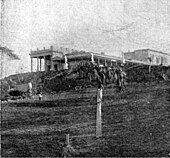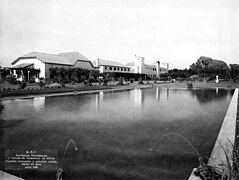Quinta de Olivos
| Quinta presidencial de Olivos | |
|---|---|
Neogothic and Baroque) | |
| Town or city | Olivos, Buenos Aires |
| Country | Argentina |
| Coordinates | 34°30′54″S 58°28′59″W / 34.51500°S 58.48306°W |
| Construction started | 1854 |
| Client | Miguel de Azcuénaga |
| Technical details | |
| Size | 32 hectares (79 acres) (estate) |
| Design and construction | |
| Architect(s) | Prilidiano Pueyrredón |
National Historic Monument of Argentina | |
The Quinta presidencial de Olivos, also known as Quinta de Olivos, is an architectural landmark in the north side Buenos Aires suburb of Olivos and the official residence of the president of Argentina. It is one of the president's official residences.
Overview
Development

Shortly after the second foundation of Buenos Aires by Captain Juan de Garay in 1580 (the first one was in 1536 by Pedro de Mendoza), among the first 400 land lots apportioned was that of a 180-hectare (440-acre) parcel 20 kilometers (12 miles) north of the city. The land, situated on a bluff overlooking the Río de la Plata, was awarded to Rodrigo de Ibarola, a lieutenant of Garay's.
A prime section of the property was purchased in 1774 by Manuel de Basavilbaso, the postmaster general of the Viceroyalty of the Río de la Plata. His daughter, Justa Rufina, married Miguel de Azcuénaga, a military officer who would later take part in the May Revolution of 1810 (prologue to the Argentine War of Independence). He also established one of the area's first apiaries on the grounds.[1]
Azcuénaga inherited the land on the death of his wife in 1829, and their son, Miguel José, in turn inherited it in 1833. He converted the property into an equestrian estate, though the rise of
Pueyrredón created an eclectic design centered on
Azcuénaga landscaped the sprawling property with a selection of
Azcuénaga, who had no legitimate offspring, bequeathed the property to his nephew, Antonio Justo Olaguer Feliú. The blind Olaguer, who had no use for the view of the waterfront, sold the easternmost portion of the land before his death in 1903 and bequeathed it to his nephew, Carlos Villate Olaguer. Villate stipulated on his receiving the property that, upon his death, it should be deeded to the
Bequeathal to State

Villate's death in 1913 made the 35-hectare (86-acre) property available to the government, though its conversion into a public park was considered for a number of years (it had been customary for Argentine Presidents to reside in their own home). President Hipólito Yrigoyen ultimately accepted the deed on September 30, 1918, though he designated it as the Residence of the Minister of Foreign Relations, rather than putting it to presidential use, and its first official occupant was Foreign Minister Honorio Pueyrredón. A coup in 1930 and the installation of General José Félix Uriburu gave the estate its first use as a presidential residence when the infirm dictator opted for the spot's breeze and tranquility during a 1931 heat wave.[1]
Uriburu's successor,
Presidential Residence
The estate's use as a year-round residence triggered a lawsuit in 1940 by Villate's heirs, alleging that it violated the terms of the will. The suit was struck down by the
The scandal helped precipitate Perón's overthrow in 1955, and General
The quinta was the site of Juan Perón's death on July 1, 1974. Perón, who had returned from exile following
The compound's opulence prompted a number of Argentine presidents over the years to forgo residing there, notably Dr.
Later additions include a
Gallery
-
Beekeping
-
Dining rooms
-
Children's building
-
Garden and statues
-
Kitchen pavillion
-
Guests pavillion
-
Entrance on Villate street
-
Main entrance on Avenida Maipú
References
- ^ a b c d e f Taringa: Residencia Presidencial de Olivos (in Spanish)
- ^ La Nación: Victoria invita a Prilidiano (in Spanish)
- ^ Revista del Notariado: La Quinta de Olivos (in Spanish)
- ^ a b c d e La Nación: Historias de la quinta presidencial (in Spanish)
- ^ Page, Joseph. Perón: A Biography. Random House, 1983.








